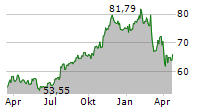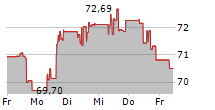
DAVOS, Switzerland, Jan. 22, 2025 (GLOBE NEWSWIRE) -- Between $25 billion and $50 billion in potential efficiency gains can be realized through targeted enhancements in banks' Risk and Compliance functions alone without compromising effectiveness, according to a report released by Nasdaq and Boston Consulting Group (BCG). The report, titled "The New Growth Imperative: Cutting through Complexity in the Financial System" reviews the interconnected challenge of complexity and complicatedness and finds that while external complexity continues to increase, excess layers of internal complicatedness have accumulated.
"Financial institutions are particularly exposed to the exponential growth in complexity across the global economy, from the evolution of technology paradigms to the expectation of real-time finance and the explosion of data. What's more, regulators have put banks on the front line in the fight against financial crime and cyber-attacks," said Nasdaq Chair and CEO Adena Friedman. "The good news is that as both external complexity and internal complicatedness have grown, so have the solutions to help manage them. By leveraging modern technology and embracing a systems-based approach, we can unlock significant efficiencies and foster a more resilient and innovative ecosystem towards the dual goal of resilience and growth. At a time where the demand for long-term capital is exploding and political mandates are geared toward change, this report provides novel perspectives on how we can better tackle complexity without adding to the mounting body of complicatedness."
"We are at an inflection point. The dramatic increase in complexity in business operating environments, furthered by advances in technology over the past decade, is adding cost and friction to our financial system," said BCG CEO Christoph Schweizer. "Our research highlights significant opportunities for efficiency gains with equal or greater effectiveness and improved performance outcomes that could unlock up to $1 trillion of lending capacity."
Whereas complexity can be viewed as external factors beyond the control of individual organizations, complicatedness arises from how organizations respond, and the mechanisms created to adapt to that complexity. Nasdaq's analysis suggests that by reducing complicatedness in processes across bank Risk & Compliance functions, significant resources can be released and deployed towards critical investment areas such as the digitization of the global economy, the modernization of our energy systems, and the need for next-generation power solutions to enable the artificial intelligence revolution.
In addition, the report finds that financial institutions are turning toward strategic technology partners that offer holistic best-in-class solutions to their biggest risk and compliance challenges as a means of addressing the exponential increase in complexity. Only 22% of industry professionals have a preference to build software solutions in house, indicating that industry recognizes the value of systems-based solutions from trusted partners.
"The most effective solutions will require a comprehensive recalibration of people, processes, and systems," said Tal Cohen, President of Nasdaq. "By shifting from lengthy manual processes to systems-based and people-led processes, human capital can be unlocked to focus on decision-making, risk management, oversight, analysis, and innovation. Getting this right can unlock significant value through efficiency gains. But that only tells part of the story. The transformative potential of AI will redefine every industry - including the financial industry - in the years ahead. The very same solutions that sit at the core of the complicatedness challenge, will serve as the foundation for success in tomorrow's AI-enabled world. As such, effectively addressing these issues today could protect and reinforce competitiveness well into the future."
The report also provides a call to action to bank leaders to amplify the talent of their teams by shifting from a people-based to a people-led approach, where systems serve as the base of unleashing human potential, reducing rote processes and procedures and leveraging the scale of software platforms to achieve the same level of effectiveness with significantly enhanced efficiency. This call also includes encouraging all stakeholders in the ecosystem, including regulators, to embrace new ways of working and to better embrace the capabilities of modern technology.
Additional Insights from the Report:
- Increasing Complexity in Financial Institutions:
- Research revealed that throughout just over a half-century, while external complexity had increased more than 6-fold, organizational complicatedness in response had increased more than 35-fold.
- The complexity of the operating environment within the global financial system has increased 2x-3x over the past decade, driven by external factors such as increased regulations and an interconnected global financial system.
- The number of new regulations per year are now more than 6x what they were during the Global Financial Crisis.
- Cost of Complexity:
- Despite significant investments in the digitization of the financial system - i.e. $800 billion in annual tech investments, 30% decrease in bank branches in the U.S. alone - overall operating costs for banks have not meaningfully declined or improved.
- In addition, significant costs continue to be associated with non-compliance for banks with nearly $250 billion spent on regulatory fines - this number excludes the financial impact of financial crime and related costs to the financial system.
- The Time is Now, and the Opportunity is Significant:
- Bank executives see significant opportunities for efficiency gains and improved outcomes from modernization solutions. This could result in annual savings of $25 billion - $50 billion in Risk & Compliance operating expenditures, unlocking up to $1 trillion in lending capacity.
- This is particularly powerful given the $80 trillion required over the next few decades to support major transformation themes across the global economy.
- Transformation Through Technology:
- The financial system is now at a point where this transformation is technologically and culturally possible, with increased comfort in leveraging cloud-based solutions.
- For example, the level of comfort to leverage and deploy cloud-based solutions across the industry has increased from 11% in 2014 to 93% in 2024.
- Today, bank leaders cite comfort in AI similar to that of cloud five years ago - paving a runway for similar comfort in AI to build over the next five years.
- Additionally, only 22% of respondents have a preference to build software solutions in house, indicating that industry is looking for systems-base solutions from trusted partners.
Data, insights and research included within the report were based on interviews with senior banking leaders, an assessment of industry data sources, and a survey of industry professionals. More about this research and the full report are available here.
About Nasdaq
Nasdaq (Nasdaq: NDAQ) is a leading global technology company serving corporate clients, investment managers, banks, brokers, and exchange operators as they navigate and interact with the global capital markets and the broader financial system. We aspire to deliver world-leading platforms that improve the liquidity, transparency, and integrity of the global economy. Our diverse offering of data, analytics, software, exchange capabilities, and client-centric services enables clients to optimize and execute their business vision with confidence. To learn more about the company, technology solutions, and career opportunities, visit us on LinkedIn, on X @Nasdaq, or at www.nasdaq.com.
-NDAQG-
Media Relations Contact:
Marleen Geerlof
+1.347.265.1687
Marleen.Geerlof@Nasdaq.com





